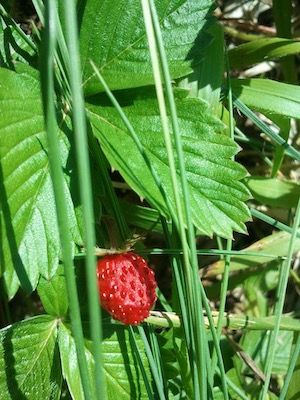WILD STRAWBERRY
I- Nomenclature
Latin name: Fragaria Vesca
Family : Rosaceae
Common names: Woodland strawberry, Alpine strawberry, Carpathian strawberry, Eurpopean strawberry 1
Etymology
There are two theories as to the true origin of the word, both deriving from its first syllable. One explanation hinges on a particular meaning of “straw” — a particle of straw, chaff, or mote — describing the appearance of the achenes (tiny y
ellow seeds) scattered over the surface of the berry. Another view says it comes from “stray” or “strew,” designating the spread of the plant’s runners (slender tendrils), in that in an unchecked field of strawberries the plants appear to have been strewn across the ground with their runners straying everywhere. This second explanation is the more popular.2
II- Legends and traditions
Evidence from archaeological excavations suggests that Fragaria vesca has been consumed by humans since the Stone Age1
III- Botanical description
Description: Wild strawberry is a perennial herbaceous plant, forming a low tuft.
The leaves of the base, with long petiole, are trifoliolate, toothed. The more or less hairy blade is often slightly folded along the secondary veins. The terminal leaf tooth is as tall or longer than its two neighbors, unlike the false strawberry.
The flowering stems can reach 30 to 40 cm. The white flowers bloom from April to July. The plant sometimes blooms again in autumn.
The fruit (false fruit) is formed by the entire receptacle of the flower. It has a red or whitish yellow color depending on the variety, and an oblong ovoid shape more or less rounded.
The plant gives off numerous elongated horizontal branches, named suckers bearing buds from place to place. These twigs are runners, which emit adventitious roots at the level of the leaves and take root forming new stems.
Habitat: The wild strawberry is spontaneous in the woods: clearings, edges, wooded grassy paths and their slopes.
It is a plant that blooms in the spring, before the deciduous trees capture most of the sunlight.
IV- Active ingredients
|
Leaves, fruits and root |
|
⬧ Tannins ⬧ mucilage ⬧ sugars ⬧ salicylates ⬧ minerals, vitamins B, C, E |
V- Therapeutic uses
Properties
|
Leaves, fruits and root |
|
⬧Astringent ⬧depurative ⬧diuretic ⬧laxative ⬧hepatic tonic ⬧vulnerary |
Indications
Urinary tract disorders, urolithiasis, renal colic;
Asthma;
Diarrhea;
Intestinal bleeding;
Hepatic, jaundice;
Leucorrhea;
Rheumatism, gout.
Dosage
- Leaves
Decoction: to be taken for diarrhea, gastric inflammations and infections and for jaundice: 2 tablespoons for ½ liter of cold water, boil 3 to 4 minutes.
Combine with meadowsweet or St. John's Wort for mild arthritis pain, or with celery seed for gout.
Liquor: against diarrhea: 400 grams of leaves for 1 liter and ½ of brandy, boil until the liquid is reduced to 55 centiliters. Filter. Take 1 tablespoon every 3 hours until the diarrhea stops.
- Fruit
Fresh: eat the fruit for gastritis or as a liver tonic; they are useful during convalescence from hepatitis. They are also used in feverish conditions because they are refreshing and do not cause stomach problems.
Poultice: apply a poultice of crushed fresh fruit to sunburn or skin inflammation.
Wine: macerate the fruit in wine to make a traditional remedy to "revive the spirits and make the heart happy".
- Root
Decoction: diuretic, against enteritis, internal bleeding, dysentery, cystitis, gout, bladder or liver stones, arthritis: 30g per liter of water.
VI- Precaution of use
Contraindication
May cause allergic reactions in people sensitive to strawberries.
Interaction: incompatible with iron sulphate.
1 https://en.wikipedia.org/wiki/Fragaria_vesca



